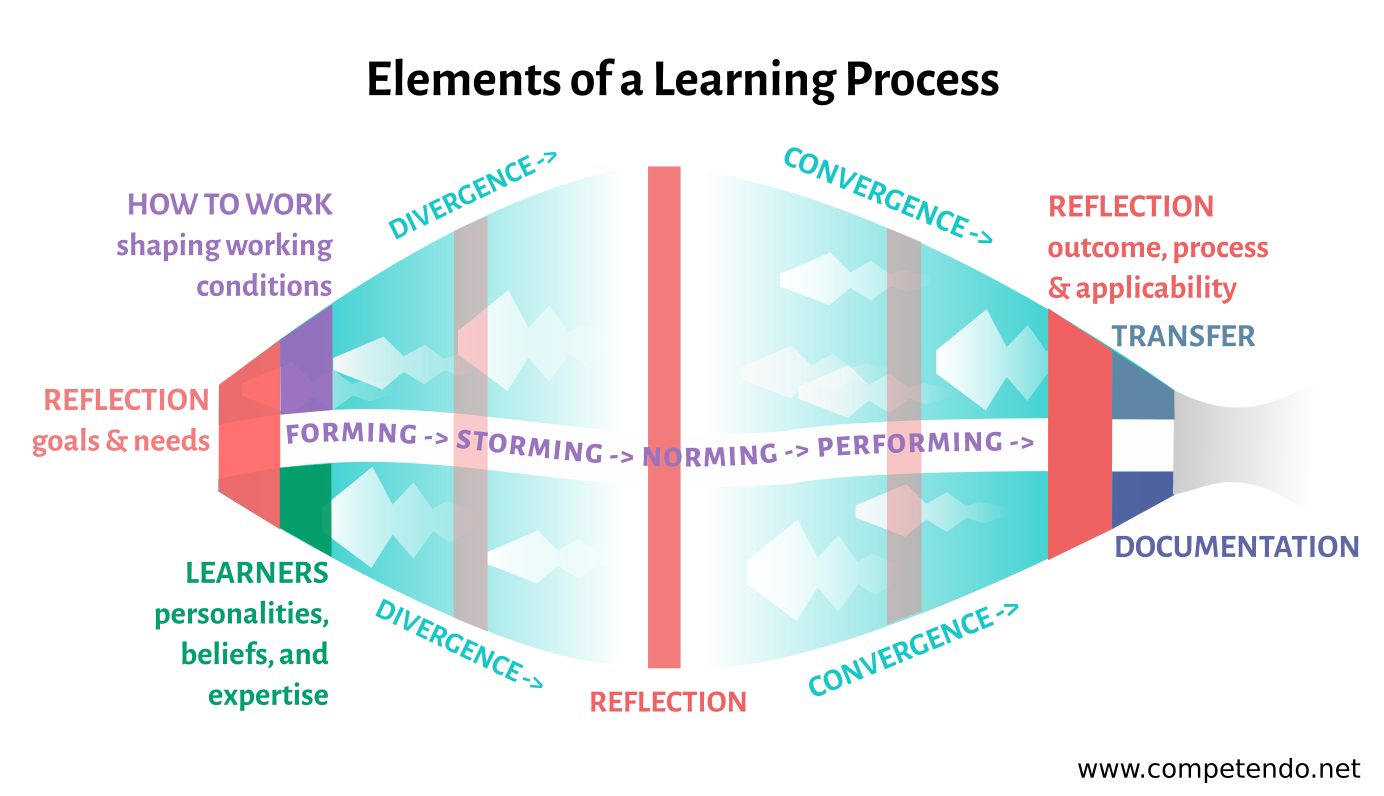You, your institution or school and your participants have different preferences and expectations regarding the common learning process. Planning is the art of considering the diversity of stakeholders around a learning and the diversity within a group in all its qualities, while ensuring that all of its parts gain from it.

A learning process is consisting on the standard elements described in detail in the During section. No matter if it's lasting several days, some hours, or only one hour, the working conditions need to be clarified, or learners need to be enabled to involve their qualities, curiosity and expertise.
At several stages of a longer process they need as well opportunities to reflect on their questions, or assess their learning. Similar, at the end of the process a final reflection should take place, now more focusing on the learning outcome, its relevance for their future and on the evaluation of the learning process they were into. Finally the learning outcome or competency development needs to be documented and described (by learners and facilitators).
The Four Process Dynamics in a Workshop or Training
Planning a workshop or seminar means taking into account different process dynamics. The learning as an activity is curricular, the group dynamics is evolving, the topical concept is structured, creative thinking requires methodological alternation.
1 Curricular Nature of Learning
The first is the curricular nature of learning as a circle between experience, reflection and conceptualization, Therefore, a process needs to foresee place for regular experience and regular reflection/assessment. In this picture the red stripes symbolize such regular self-observation and reasoning phases.
2 Divergence and Convergence
Second, a learning process is oscillating between two opposite ways of thinking. Divergent thinking is opening the mind toward different impulses, it is rather open-ended and explorative. Convergent thinking is narrowing our thinking, it's logical and directed toward a conclusion or result. The interplay between divergence and convergence is characterizing the whole process and as well explaining the dynamics in smaller units on a micro-level. One approach to satisfy dimensions is to mix and alternate methodology.
3 Content Order
Third, the order of the topical aspects of a learning event is shaping the processm often in a linear way. The topical string is often the only clear described program aspect, in example in a program schedule: Like the key aspects of a day, of a part of a day, or of an unit.
4 Group Dynamics
Fourth, the group dynamics needs to be taken into consideration. In particular, when a group is starting together, the phases of group development claim their space from group formation to storming, then norming toward finding into a performing mode. In order to achieve this, consider the idea of Cooperative Learning, team building measures at the beginning and recognize, that probably higher group performance will be possible during the later steps of a process.
Articles, Checklists and Methods
This is a proposal for a planning method of a workshop with the goal-content-method matrix. It helps a facilitator create a clear logical structure of the learning sessions. One gains more efficiency, transparency and flexibility when making this distinction between (absolute prior) goals and the methods we use on the way to achieve these goals.
Imagine your participants’ needs are represented by a hand with five fingers. Each finger stands for a different type of need: 1. Social, 2. Physical, 3. Intellectual, 4.Emotional and 5. Spiritual. In your seminar there should be a space for covering all five needs.
The checklist will help you to analyze your plan if its fitting contentwise and methodologically to the diverse needs of your participants.
Facilitating a conversation on expectations of participants and facilitators toward a common learning event, giving the human needs place.
The Case Study shows, how organizing a small local project can lead to the development of skills, competencies and knowledge in the organizers and the target group. Including a template for your training.
Key Competencies are abilities learners might use in a broad range of social contexts - in social participation, as employees, in their way to express their culture or for their personal development. This task helps teams and organizations to identify their key competency profile including the competencies learners, visitors or participants might learn during their activities.
Learning styles are different and when using merthods, that address different senses or ways of expression we may have a bigger impact on our participants, so that everybody feels attracted, although not everybody from the same methods. Therefore we advocate for a mix of activity/cognition, creativity/traditional learning, groupwork/individual work...
A short checklist for the beginning of your planning
Using language is using power. Sharing power and empowering participants linguistical implies to reflect the language and materials you use and to apply it in a diversity-aware way.
It's not enough to say something, it is as well important, how you say it. In a call for application, in working texts in reports or promotion texts for public audiences we represent our values, and culture - as well as our stereotypes, presumptions or limitations. Therefore we want to motivate you, to use language precisely.
Find out more about your target group. The method will help listen, empathize, and make careful observations.
A persona may represent a typical person affected by an initiative, or the initiative's target audience or group. Imagine a concrete person, with a name, habits, and clothing. Try to understand them as deeply as possible. Try to think like them, take a "walk in their shoes'". Developing these personas are the first step in helping real people and reflecting critically on our assumptions.
If we want to encourage the learners to work with and for the communities to initiate the social change, it is good to know the basics of the planning of the community work. Here the characteristics of the phases of planning community work.








